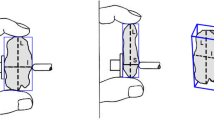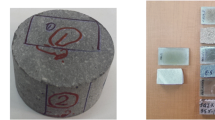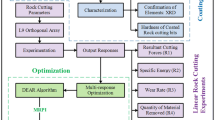Abstract
Rock cutting efficiency is the most common parameter used to evaluate the performance of polycrystalline diamond compact (PDC) bits. Many studies have shown that cuttings size might be used to evaluate rock breaking efficiency; however, there are few quantitative studies of the relationship between rock cutting efficiency and cuttings size in rock cutting when a PDC bit is used. Several linear cutting tests were conducted to explore the relationship between the mechanical specific energy (MSE) and cuttings size to solve this problem. The cuttings size distributions were also discussed. Then, the coarseness index (CI) was selected as the most appropriate indicator of cuttings size and its relationship with the MSE was investigated. In addition, rock cutting tests based on the Taguchi method were conducted to analyze cutting parameters such as the depth of cut (DOC), the back rake angle (θ) and the cutting speed (v) effects on the CI and MSE. The contribution of each parameter to the response was obtained. The results show that the distribution of cuttings size conforms to the Rosin–Rammler equation, and there is a significant relationship between the MSE and cuttings size. The MSE decreases with increased cuttings size, furthermore, the relationship between the MSE and the CI could be described by an exponent function. The Taguchi experiment results show that DOC and θ have significant impacts: the CI value increases with increased DOC, and the CI increases slightly with increased θ. The most influential factor on the CI is the DOC, followed by θ. However, within the range of experiments, the cutting speed has an insignificant effect on the CI value. This work is highly pertinent to better understanding of the relationship between rock cutting efficiency and cuttings size in rock cutting using a PDC cutter.

















Similar content being viewed by others
References
Bellin F, Dourfaye A, King W, Thigpen M (2010) The current state of PDC bit technology. World Oil 231(11):67–71
Chen L, Yang YX, Liu Y, Lin M, Zhang CL, Niu SW (2017) The operational theory and experimental study of scraping-wheel diamond bit. J Petrol Sci Eng 156:152–159
Iman R, Babak A, Brian E (2018) Analysis of rock cutting process with a blunt PDC cutter under different wear flat inclination angles. J Petrol Sci Eng 171:771–783
Caicedo HU, Calhoun WM, Ewy RT (2005) Unique ROP predictor using bit-specific coefficient of sliding friction and mechanical efficiency as a function of confined compressive strength impacts drilling performance. In: SPE/IADC drilling conference and exhibition, Feb 23–25, Amsterdam, The Netherlands
Hareland G, Yan W, Nygaard R, Wise JL (2009) Cutting efficiency of a single PDC cutter on hard rock. J Can Pet Technol 48(6):60–65
Liu W, Zhu X (2019) A new approach of rock cutting efficiency evaluation by using plastic energy dissipation ratio. KSCE J Civ Eng 23(2):879–888
Wang X, Wang Z, Wang D, Chai L (2018) A novel method for measuring and analyzing the interaction between drill bit and rock. Measurement 121:344–354
Teale R (1965) The concept of specific energy in rock drilling. Int J Rock Mech Min Sci Geomech Abstr 2(2):57–73
Chen P, Meng M, Miska S, Yu M, Ozbayoglu E, Takach N (2019) Study on integrated effect of PDC double cutters. J Pet Sci Eng 178:1128–1142
Thomas GB, Steven CF (1991) Specific grinding energy as an in-process control variable for ductile-regime grinding. Precis Eng 13(4):256–262
Richard T (1999) Determination of rock strength from cutting tests. University of Minnesota, Minneapolis
Richard T, Dagrain F, Poyol E, Detournay E (2012) Rock strength determination from scratch tests. Eng Geol 147–148:91–100
Zhou Y, Lin JS (2013) On the critical failure mode transition depth for rock cutting. Int J Rock Mech Min Sci 62:131–137
He X, Xu C, Peng K, Huang G (2017) On the critical failure mode transition depth for rock cutting with different back rake angles. Tunn Undergr Space Technol 63(3):95–105
He X, Xu C (2016) Specific energy as an index to identify the critical failure mode transition depth in rock cutting. Rock Mech Rock Eng 49(4):1461–1478
Hong J, Fan X, Liu Y, Liu G, Liu B, Talalay P (2015) Size distribution and shape characteristics of ice cuttings produced by an electromechanical auger drill. Cold Reg Sci Technol 119(11):204–210
Rispoli A, Ferrero AM, Cardu M, Farinetti A (2017) Determining the particle size of debris from a tunnel boring machine through photographic analysis and comparison between excavation performance and rock mass properties. Rock Mech Rock Eng 50:2805–2816
Akbari B, Miska S, Yu M, Ozbayoglu E (2014) Relation between the mechanical specific energy, cuttings morphology, and PDC cutter geometry. In: Proceedings of the ASME 2014 33rd international conference on ocean, offshore and arctic engineering. Materials technology; petroleum technology, vol 5. June 8–13, San Francisco, California, USA
Zhen C, Mao S, Gensheng L, Zhongwei H, Xiaoguang W, Zhaopeng Z, Jiawei Y (2018) Imaging the formation process of cuttings: characteristics of cuttings and mechanical specific energy in single PDC cutter tests. J Pet Sci Eng 171:854–862
Hughes HM (1986) The relative cuttability of coal-measures stone. Min Sci Technol 3(2):95–109
Tuncdemir H, Bilgin N, Copur H, Balci C (2008) Control of rock cutting efficiency by muck size. Int J Rock Mech Min Sci 45(2):278–288
Roxborough FF, Rispin A (1973) The mechanical cutting characteristics of the lower chalk. Tunn Tunn Int 5:45–67
Heydari S, Hamidi JK, Monjezi M, Eftekhari A (2019) An investigation of the relationship between muck geometry, TBM performance, and operational parameters: a case study in golab II water transfer tunnel. Tunn Undergr Space Technol 88(1):73–86
Che D, Zhang W, Ehmann K (2017) Chip formation and force responses in linear rock cutting: an experimental study. J Manuf Sci Eng 139(1):011011
Rajabov V, Miska SZ, Mortimer L, Yu MJ, Ozbayoglu ME (2012) The effects of back rake and side rake angles on mechanical specific energy of single PDC cutters with selected rocks at varying depth of cuts and confining pressures. In: IADC/SPE drilling conference and exhibition, Mar 6–8, San Diego, California, USA
Menezes PL (2017) Influence of cutter velocity, friction coefficient and rake angle on the formation of discontinuous rock fragments during rock cutting process. Int J Adv Manuf Technol 90:3811–3827
Rafatian N, Miska SZ, Ledgerwood LW, Yu MJ, Ahmed R (2009) Experimental study of MSE of a single PDC cutter under simulated pressurized conditions. In: SPE/IADC drilling conference and exhibition, Mar 17–19, Amsterdam, The Netherlands
Xia HN, Wang KX, Zhai YH, Cai JL (1997) Experimental research of PDC cutter shapes on breaking rock efficiency under various confining pressures. J Jianghan Pet Inst 19:48–50 (in Chinese)
Akbari B, Miska S, Mengjiao Y, Ozbayoglu E (2013) Effect of rock pore pressure on mechanical specific energy of rock cutting using single PDC cutter. In: 47th U.S. rock mechanics/ geomechanics symposium, June 23–26, San Francisco, California, USA
Hegde C, Daigle H, Millwater H, Gray K (2017) Analysis of rate of penetration (ROP) prediction in drilling using physics-based and data-driven models. J Pet Sci Eng 159:295–306
Rosin P, Rammler E (1933) The laws governing the fineness of powdered coal. J Inst Fuel 7:29–36
Wang X (2017) Study on rock breaking mechanism using conical picks and cutting performance of roadheaders. Chongqing University, Chongqing (in Chinese)
Javad S, Masoud G, Aliakbar A, Enayatolah D (2018) Optimisation of drilling parameters on St37 based on Taguchi method. J Braz Soc Mech Sci Eng 40:370
Acknowledgements
This work was supported by National Natural Science Foundation of China (Grant No. 51874327) and Scientific Research Starting Foundation of China University of Petroleum-Beijing at Karamay (RCYJ2016B-02-004).
Author information
Authors and Affiliations
Corresponding author
Additional information
Technical Editor: Celso Kazuyuki Morooka.
Publisher's Note
Springer Nature remains neutral with regard to jurisdictional claims in published maps and institutional affiliations.
Appendix: The results of the experiments in Section 3
Appendix: The results of the experiments in Section 3
\(\theta\)(°) | DOC (mm) | Cuttings weight (mg) | Parameters of Rosin–Rammler equation | CI | |||||||
|---|---|---|---|---|---|---|---|---|---|---|---|
< 20 | 20–40 | 40–60 | 60–80 | 80–100 | > 100 | \(n_{b}\) | \(r_{e}\) | \(R^{2}\) | |||
(mesh) | (mesh) | (mesh) | (mesh) | (mesh) | (mesh) | (mm) | |||||
5 | 0.1 | 0.8 | 6.1 | 2.4 | 3.2 | 2.8 | 23.1 | 0.66 | 0.016 | 0.97 | 216.67 |
0.2 | 1.4 | 13.4 | 14.3 | 6.4 | 4.8 | 46.6 | 10.99 | 0.021 | 0.99 | 239.46 | |
0.3 | 4.3 | 23.2 | 18.8 | 8.4 | 6.0 | 52.9 | 0.97 | 0.026 | 0.99 | 239.46 | |
0.4 | 37.7 | 65.4 | 23.3 | 10.4 | 7.6 | 76.0 | 0.83 | 0.046 | 0.98 | 270.25 | |
0.5 | 124.4 | 140.8 | 48.1 | 22.5 | 15.5 | 142.2 | 0.81 | 0.046 | 0.98 | 348.91 | |
0.8 | 191.5 | 80.35 | 33.2 | 16.4 | 11.7 | 68.3 | 0.80 | 0.122 | 0.99 | 454.49 | |
1.2 | 378.1 | 101.2 | 42.0 | 20.2 | 13.6 | 76.8 | 0.80 | 0.191 | 0.99 | 491.78 | |
1.6 | 427.6 | 99.5 | 48.6 | 24.7 | 16.8 | 93.5 | 0.74 | 0.201 | 0.99 | 486.71 | |
2.0 | 422.9 | 85.8 | 38.8 | 17.6 | 11.3 | 63.1 | 0.81 | 0.245 | 0.99 | 509.86 | |
10 | 0.1 | 0 | 7.3 | 7.6 | 4.2 | 3.0 | 32.8 | 0.84 | 0.017 | 0.99 | 215.42 |
0.2 | 0.2 | 8.1 | 10.9 | 6.7 | 5.3 | 39.2 | 1.17 | 0.019 | 0.99 | 220.01 | |
0.3 | 1.1 | 18.6 | 16.4 | 8.0 | 5.5 | 46.0 | 1.13 | 0.023 | 0.98 | 257.40 | |
0.4 | 20.7 | 61.0 | 21.8 | 9.9 | 6.9 | 58.7 | 0.98 | 0.042 | 0.97 | 345.62 | |
0.5 | 75.9 | 70.2 | 26.5 | 12.3 | 8.7 | 68.9 | 0.82 | 0.068 | 0.99 | 394.53 | |
0.8 | 213.7 | 90.9 | 35.9 | 18.7 | 13.8 | 85.2 | 0.76 | 0.121 | 0.99 | 447.26 | |
1.2 | 461.2 | 107.3 | 53.4 | 27.2 | 19.1 | 106.2 | 0.73 | 0.199 | 0.99 | 483.39 | |
1.6 | 668.5 | 131.3 | 65.5 | 34.7 | 22.4 | 121.4 | 0.75 | 0.238 | 0.99 | 498.20 | |
2.0 | 940.9 | 164.5 | 80.2 | 38.4 | 26.1 | 128.4 | 0.79 | 0.271 | 0.99 | 513.93 | |
15 | 0.1 | 0 | 2.5 | 3.7 | 5.7 | 3.8 | 15.3 | 1.39 | 0.019 | 0.98 | 217.10 |
0.2 | 2.8 | 18.7 | 13.7 | 8.4 | 6.5 | 39.7 | 1.03 | 0.026 | 0.99 | 270.60 | |
0.3 | 18.2 | 37.3 | 20.2 | 9.6 | 6.6 | 51.9 | 0.89 | 0.038 | 0.99 | 327.12 | |
0.4 | 43.7 | 58.4 | 24.1 | 12.5 | 9.5 | 67.3 | 0.84 | 0.050 | 0.99 | 359.41 | |
0.5 | 79.7 | 63.4 | 26.8 | 13.3 | 10.5 | 71.0 | 0.78 | 0.068 | 0.99 | 390.76 | |
0.8 | 238.6 | 90.5 | 40.7 | 18.8 | 13.8 | 73.8 | 0.82 | 0.130 | 0.99 | 462.98 | |
1.2 | 391.9 | 116.0 | 58.2 | 27.7 | 20.0 | 106.6 | 0.78 | 0.154 | 0.99 | 471.19 | |
1.6 | 554.6 | 133.1 | 67.9 | 33.7 | 24.7 | 127.8 | 0.75 | 0.189 | 0.99 | 482.39 | |
2.0 | 805.1 | 214.6 | 70.1 | 41.2 | 25.1 | 153.6 | 0.79 | 0.212 | 0.98 | 497.35 | |
20 | 0.1 | 0 | 1.4 | 1.2 | 3.6 | 5.2 | 24.5 | 1.07 | 0.012 | 0.99 | 160.17 |
0.2 | 8.0 | 5.0 | 6.4 | 4.8 | 3.1 | 35.2 | 0.70 | 0.015 | 0.99 | 246.92 | |
0.3 | 30.9 | 47.3 | 22.0 | 11.3 | 8.2 | 70.2 | 0.78 | 0.039 | 0.99 | 331.95 | |
0.4 | 12.6 | 38.8 | 17.7 | 9.2 | 7.1 | 62.4 | 0.87 | 0.032 | 0.98 | 300.61 | |
0.5 | 48.2 | 53.7 | 24.1 | 11.6 | 9.3 | 76.1 | 0.75 | 0.050 | 0.99 | 351.44 | |
0.8 | 219.1 | 100.7 | 46.7 | 10.6 | 3.0 | 101.8 | 0.74 | 0.106 | 0.98 | 432.02 | |
1.2 | 409.0 | 125.1 | 57.7 | 30.5 | 20.9 | 121.1 | 0.75 | 0.154 | 0.99 | 466.39 | |
1.6 | 598.0 | 125.1 | 67.7 | 32.5 | 23.1 | 128.5 | 0.74 | 0.207 | 0.99 | 488.02 | |
2.0 | 743.5 | 151.3 | 77.3 | 33.8 | 25.1 | 159.7 | 0.73 | 0.260 | 0.98 | 503.45 | |
25 | 0.1 | 0 | 0 | 1.4 | 2.2 | 2.2 | 21.7 | 1.26 | 0.010 | 0.99 | 138.76 |
0.2 | 0 | 1.2 | 1.8 | 2.5 | 3.1 | 26.1 | 0.93 | 0.010 | 0.94 | 152.24 | |
0.3 | 0 | 3.0 | 9.8 | 5.0 | 5.0 | 41.4 | 1.07 | 0.015 | 0.98 | 187.85 | |
0.4 | 4.3 | 30.0 | 22.5 | 10.6 | 7.5 | 60.8 | 1.03 | 0.026 | 0.99 | 275.02 | |
0.5 | 24.3 | 52.5 | 27.4 | 13.0 | 8.9 | 65.8 | 0.93 | 0.040 | 0.99 | 333.78 | |
0.8 | 290.0 | 93.5 | 53.6 | 26.2 | 18.0 | 95.4 | 0.78 | 0.129 | 0.99 | 456.44 | |
1.2 | 455.1 | 129.6 | 62.8 | 33.3 | 22.7 | 121.6 | 0.76 | 0.160 | 0.99 | 472.30 | |
1.6 | 461.9 | 149.2 | 74.7 | 39.0 | 27.7 | 151.5 | 0.75 | 0.138 | 0.99 | 457.97 | |
2.0 | 1238.6 | 184.1 | 99.1 | 48.0 | 33.2 | 182.0 | 0.71 | 0.328 | 0.99 | 512.12 | |
1. CI is coarseness index, R2 is the correlation coefficient of the fitted curves of Rosin–Rammler equation. 2. Rosin–Rammler equation: \(R = {\text{100exp}}\left( { - \left( {r_{{\text{c}}} /r_{e} } \right)^{{n_{b} }} } \right)\), where R is the cumulative fraction of cuttings by weight retained on the sieve that of mesh size rc, re is the absolute grain size, nb is a constant describing the uniformity of the cuttings.
Rights and permissions
About this article
Cite this article
Hou, H., Liu, Z., Zhu, H. et al. An experimental study of the relationship between cutting efficiency and cuttings size in rock cutting using a PDC cutter. J Braz. Soc. Mech. Sci. Eng. 43, 270 (2021). https://doi.org/10.1007/s40430-021-02984-9
Received:
Accepted:
Published:
DOI: https://doi.org/10.1007/s40430-021-02984-9




